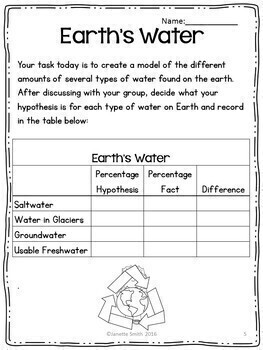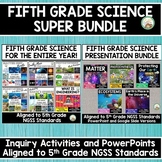5th Grade Science -NGSS Aligned- Entire Year Bundle
- Zip
What educators are saying
Products in this Bundle (9)
showing 1-5 of 9 products
Bonus
Also included in
- I decided to put this MEGA BUNDLE together because I have noticed that several buyers purchase multiple SCIENCE ENTIRE YEAR Super Bundles for different grade levels. I’m guessing these buyers are science teachers at the elementary level, homeschool parents with multiple levels of kids, or principalPrice $342.16Original Price $427.70Save $85.54
- This product has everything you need to teach 5th grade Science. This product is aligned to the Next Generation Science Standards for 5th Grade. By teaching these units you will be covering every single NGSS standard for 5th grade science.Included in this product are 6 hands on units that teach alPrice $73.12Original Price $91.40Save $18.28
- This Bundle includes 6 Units aligned to NGSS standard for 5th Grade Science. This bundle includes both PDF Printable Files and the Google Classroom™ Digital Format. Presentations are also in Google Slides format and PowerPoint.This product gives teachers options to provide some activities in paperPrice $128.00Original Price $160.00Save $32.00
Description
This bundle includes 6 different hands-on science aligned to the 5th grade NGSS (Next Generation Science Standards) Each unit is packed full of inquiry-based activities, integrated language arts, word wall cards, games, task cards, projects, and assessments. Teacher pages, answer keys, and assessments are also included. Here's a brief description of each unit. If the preview is difficult to see, you can visit the page for each item by clicking the links since each unit is also sold separately. You will save money by purchasing all of these units.
This product is now also available in a digital format for use with Google Classroom. Check that out here.
If you want BOTH printable and digital formats click here.
Unit 1: Matter
This unit is actually 4 different units bundled into one.
Activity 1: Periodic Table Card Sort to help introduce the Periodic Table
Activity 2: Understanding the Element Square Students will learn to read an element square and gain information about an element.
Activity 3: Atom Building Challenge Students build models of atoms using toothpicks and candy (Detailed lesson plan and student activity sheets and answer keys included)
Activity 4: Lego Atoms Students use Lego to represent elements. They then build compounds and molecules to help construct understanding of abstract vocabulary.
Activity 5: Atom Foldable Students create a foldable to help review vocabulary from the mini unit
The Atoms Family Song (sung to the tune of the Adam’s Family)
Word Wall Cards and Games
Assessment and Key
Activity 1: States of Matter Log: Students keep track of different states of matter they encounter in their lives. Turn this into a class competition!
Activity 2: Movin’ Molecules Students explore how molecules move in solids, liquids, and gases. (Detailed lesson plan and student activity sheets and answer keys included.)
Activity 3: Witch’s Brew Students engage in a hands on activity using dry ice and dish soap to investigate sublimation. (Detailed teacher instructions and student activity sheet included.)
Activity 4: It’s a Solid, It’s a Liquid! Students engage in a hands on activity using a cornstarch and water mixture to investigate a colloid. Teacher directions and student activity sheet included.)
Activity 5: States of Matter Foldable Students create a foldable to help review vocabulary from the mini unit
Word Wall Cards and Games
Assessment and Key
Activity 1: The Properties Game This first activity is a game to help develop a conceptual understanding of what a property is in reference to matter.
Activity 2: Separating Mixtures In this activity, students use unique properties of different objects to separate a mixture. Math is integrated into this lesson using mass and percentage. (A detailed lesson plan and student activity sheets are included.)
Activity 3: Investigating Volume Students investigate finding the volume of irregular shaped objects using displacement.
Activity 4: Students investigate the density of different fruits.
Activity 5: Density Columns Students explore the density of different liquids and create a density column.
Word Wall Cards and Games
Assessment and Key
•Activity 1: White Powder Investigation This first activity allows students to investigate how a substance can change in size and shape, but retain it’s properties.
•Activity 2: Physical Change Foldable This foldable summarizes the different types of changes that do not change the chemical make up of something. Categories help students solidify this concept.
•Activity 3: Film Canister Rockets In this highly engaging activity, students create a simple chemical reaction inside a film canister rocket and watch as it blasts off. The idea of variables is introduced as students experiment to make their rocket go the highest.
•Activity 4: Chemistry in a Bag This exciting and efficient experiment lets students investigate common indicators of chemical change such as heat change, color change, and gas production. All this in the confines of a Ziploc bag!
•Activity 5: What Happens to the Mass Students experiment with a chemical reactions to conclude that mass is conserved in reactions.
•Activity 6: Pop it Up Students continue their investigation into the conservation of mass.
Word Wall Cards and Games
•Assessment and Key
Unit 2: Earth's Place in the Universe
Activity 1: Relative distances of planets activity using toilet paper squares
Activity 2: Gravity activities to uncover common misconceptions
Activity 3: Investigation of mass and weight on different planets
Activity 4: creation of a sun dial to help understand shadows and the movement of the Earth in relation to the sun
Activity 5: Layers of the Atmosphere activity
Activity 6: Analyzing data of sunrise and sunset
Activity 7: Modeling the Phases of the Moon
Activity 8: Creating and Investigating Constellations
Activity 9: Individual planet pages for reports or interactive notebooks
Activity 10: Task Cards with or without QR codes for centers and independent review of the unit
An end of unit assessment and answer key is also included with this unit.
Unit 3: Ecosystems
•Activity 1: What’s For Dinner?: Students trace their dinner back down the food chain to its source.
•Activity 2: Informational reading about Food Chains and webs. followed by questions.
•Activity 3: Making Chains: Students work cooperatively to sort animal cards into chains.
•Activity 4: This Tangled Web We Weave: Students investigate how food chains overlap to create webs.
•Activity 5: Earth’s Spheres informational reading and questions.
•Activity 6: Pass The Energy: This engaging activity allows students to see how different ecosystems can only support so many organisms
•Activity 7: What Happens When Living Things Die?: Students will observe fruits and vegetables decomposing over time.
• Activity 8: Order In The Forest: This 2-part activity lets students work cooperatively to learn about important vocabulary associated with this unit.
•Activity 9: Ecosystems Bingo: Students play ecosystems bingo to review the unit.
•Word Wall Cards and Games
•Post Test and Grading Rubric (2 options)
Unit 4: Protecting Earth's Spheres
•Activity 1: Earth’s Spheres Sort: This inquiry activity introduces students to the idea of Earth’s 4 spheres. They work in a group to sort cards into the 4 spheres of hydrosphere, geosphere, atmosphere, and biosphere.
•Activity 2: Earth’s Spheres Drawing: Students draw a picture and label all 4 spheres.
• Activity 3: Informational Reading on Earth’s Hydrosphere. Students read about Earth’s hydrosphere and answer questions.
•Activity 3: Interactions of Earth’s Spheres
•Activity 4: The Water Cycle Game: To frame the unit, students will review the water cycle to understand that our water supply on Earth is limited. This activity allows students to see how our hydrosphere and atmosphere interact.
•Activity 5: Earth’s Water: This inquiry activity helps students conceptualize the available water for human consumption. Extensions of this activity include a writing activity as well as a pie graph activity.
•Activity 6: Clean it Up: Students work cooperatively to build a water filter.
•Activity 7: Renewable and Non-Renewable Natural Resources: Students categorize resources and think about their uses.
•Activity 8: Reuse it!: Student learn why it is important to try to reuse items to avoid overfilling our landfills. Using recyclable materials, students use creativity and group work to construct something useful.
•Activity 9: The 3 R’s Poster : Students culminate the mini-unit by creating a poster sharing what they have learned about the 3 R’s. A rubric for grading is also included.
•Word Wall Cards and Activities
•Post test
Unit 5: Photosynthesis
•Activity 1: Informational Reading: What is Photosynthesis?
•Activity 2: Breathe In, Breathe Out Students investigate the relationship between plant respiration and animal respiration.
•Activity 3: Let There Be Light Students experiment with light to see how light impacts the rate of photosynthesis.
•Activity 4: Photosynthesis: It All Adds Up! Students learn the basics of chemical reactions and use models to show the process of photosynthesis.
•Activity 5: Photosynthesis and Earth’s Spheres: Students create a poster to show how different spheres interact during photosynthesis.
•Activity 6: Scene 1: Photosynthesis. Students act out the process of photosynthesis using props.
•Word Wall Cards and Activities
•Post Test Grading Rubric
Unit 6: Introduction to Engineering
This introduction to engineering includes an editable PowerPoint with notes as well as 3 engineering activities. Students will be introduced to Engineering and the Engineering Design Process. They will then have 3 opportunities to engage in the process. Easily accessible materials makes this very doable in your classroom.
In addition to the 14 slide PowerPoint, the activities include:
Activity 1: Float Your Boat: Students go through the engineering design process to create a boat. Once the boat successfully floats, they place marbles in it to see how many it can hold.
Activity 2: Build A Bridge: Students go through the engineering design process to build a bridge. After the bridge is built, they test it to see how many pennies it can hold.
Activity 3: Keep it Cold: This engaging activity challenges students to create a container to keep an ice cube frozen for as long as possible. This could easily be turned into a classroom contest.
Activity 4: Engineering Design Process Flow Chart: Students can use this sheet to review the steps they went through in the completed engineering design assignments. This could potentially be used as an assessment.
Each of these units is available for purchase separately in my store. I also have many other science topics, as well as Project Based Learning units with many middle grade math grades integrated into each.
***Also Available: 5th Grade PowerPoint Bundle to supplement this entire year activity bundle.
I also have a 5th Grade SUPER BUNDLE that includes this product and the PowerPoint Bundle. This would be ideal if you do not have any science textbooks to provide content background. ****
If you like this Bundle, please consider following my store; All new products are 50% off for the first 48 hours. Feedback is always appreciated!!
Teach Kindergarten? Check out the NGSS Entire Year Bundle:
Teach 1st Grade? Check out the NGSS Entire Year Bundle:
Teach 2nd Grade? Check out the NGSS Entire Year Bundle:
Teach 3rd Grade? Check out the NGSS Entire Year Bundle:
Teach 4th Grade: Check out the NGSS Entire Year Bundle:
Are you a principal, elementary science teacher or homeschool parent interested in these Entire Year Bundles for multiple grade levels? You can now purchase the NGSS Mega Bundle for an even bigger discount. This MEGA BUNDLE includes entire year science bundles aligned to NGSS for grades 1-5. Check it out here:
******Click Here to Download a FREE Science Research Report resource******
*The Next Generation Science Standards (NGSS) is a registered trademark of WestEd. Neither WestEd nor the lead states and partners that developed the Next Generation Science Standards were involved in the production of this product, and do not endorse it.








